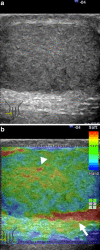Real-time tissue elastography for testicular lesion assessment
- PMID: 22028111
- PMCID: PMC3297754
- DOI: 10.1007/s00330-011-2312-2
Real-time tissue elastography for testicular lesion assessment
Abstract
Objectives: To assess the ability of Real-time Elastography (RTE) to differentiate malignant from benign testicular lesions.
Methods: In 88 testicles ultrasound identified 144 lesions, which were examined by RTE. Elasticity images of the lesions were assigned the colour-coded score of Itoh (Radiology 2006), according to the distribution of strain induced by light compression. RTE findings were analysed considering shape (nodular/pseudo-nodular), size (<5 mm, 6-10 mm, >11 mm) and score (SC1-5) of the lesions.
Results: 93.7% of all benign lesions showed a complete elastic pattern (SC1). 92.9% of benign nodules <5 mm and 100% of the pseudonodules showed a nearly complete elastic pattern (mainly SC1). 87.5% of malignant nodules showed a stiff pattern (SC4-5). RTE gave 87.5% sensitivity, 98.2% specificity, 93.3% positive predictive value, 96.4% negative predictive value and 95.8% accuracy in differentiating malignant from benign lesions.
Conclusions: RTE is a useful technique in assessing small testicular nodules and pseudo-nodules. This is relevant in clinical practice allowing expectant management in RTE selected cases. The role of RTE seems less relevant for larger lesions because most of them are malignant at clinical and ultrasound assessment, limiting RTE to simply confirmation role.
Key points: An emerging role for Elastography in allowing surveillance for small testicular lesions. Elastography can better differentiate benign from malignant testicular lesions. Follow up can be reduced for elastic testicular lesions at Elastography.
Figures





Comment in
-
Re: real-time tissue elastography for testicular lesion assessment.J Urol. 2013 May;189(5):1719-20. doi: 10.1016/j.juro.2013.01.042. Epub 2013 Jan 19. J Urol. 2013. PMID: 23594633 No abstract available.
References
-
- Ragheb D, Higgins JL., Jr Ultrasonography of the scrotum: technique, anatomy and pathologic entities. J Ultrasound Med. 2002;21:171–185. - PubMed
-
- Mihmanli I, Kantarci F. Sonography of scrotal abnormalities in adults: an update. Diagn Interv Radiol. 2009;15:64–73. - PubMed
-
- Krouskop TA, Dougherty DR, Vinson FS. A pulsed Doppler ultrasonic system for making noninvasive measurements of the mechanical properties of soft tissue. J Rehabil Res Dev. 1987;24:1–8. - PubMed
MeSH terms
LinkOut - more resources
Full Text Sources
Other Literature Sources
Medical
Miscellaneous

